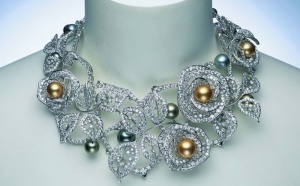Enamel – color decoration
 Even in ancient times, metal decorations were decorated with colored enamel and even then they had different uses of the decorative properties of this multi-colored glass mass.
Even in ancient times, metal decorations were decorated with colored enamel and even then they had different uses of the decorative properties of this multi-colored glass mass.
The enamel was popular in later times, and the art of enamel along with other techniques of gold-making occupied an honorable, and at times, leading place.
Enameling is called full or partial coating of a metal surface with a glass mass, followed by firing of the product. Three types of enamel are known: with a colorless base, which is called a glaze, translucent and impermeable enamel. In the enamel business there are various techniques and methods of processing.
In the overgrown enamel, wire or strips are soldered onto the metal surface and the cells thus formed are filled with glass mass. After firing, the surface is polished smoothly, so that the metal with enamel forms a flat plane, and metal lintels create a certain pattern.
This method of enameling was especially common in the East. The metal base is usually gold, less often silver or copper, the glaze is initially melted on it, then other paints are applied and, finally, colorless transparent enamel with glaze as a protective and glazing agent. Enamel on filigree is similar to cloisonne enamel, in which the wires remain higher than the enamel layer, so that the surface of the object is not tied together. Russian and Hungarian folk ornaments are characterized by this type of enamel. In central Europe, prefabricated enamel was preferred.
In this case, recesses are made on the metal surface with the help of a cutter, which are then filled with glass mass. Copper or bronze often forms the metal base; gold and silver are less used.
The surface of the enameled objects in this way is smoothly polished and appears as one, as in the cloisonne enamel. If the metal base; of a noble metal, the preference is given to a transparent glass mass, the color of which may change under the influence of the bed. To increase the intensity of color and the effect of transparent enamel with red and yellow tones, gold foil is selected, with blue and green; silver high test.
Recently, the so-called window enamel is once again very popular, in which there is no metal base and the glass mass completely fills through spaces of the wire network. The so-called enamel on silver or enamel on carving is very effective. Drawing in the form of a shallow relief is cut on a silver bed and then completely covered with a transparent glass mass.
At higher places of relief, silver shines through stronger, whereas in deeper enamels are thicker and darker. In such products the cut-off modeling of metal is fully detected. This technique was brought to the highest perfection especially by Italian goldsmiths of the 15th century. In the method, which was used mainly in France and is called barrel enamel, loosely mounted or round parts are completely covered with a layer of enamel.
Enamel on the relief is called cast or chased objects, which are fully or partially burned in a transparent or impermeable glass mass, so that a colored enamelled plastic is obtained; relief can also be enameled in a similar way. In the enamel painting, which flourished in Limoges in the 16th century, the metal plate, the recipient, is also used as a painting base.
Often made from copper, but equally from iron, silver or gold, this plate is primarily completely covered with transparent glaze or monochrome opaque enamel. Opaque glass masses are almost always used as enamel paints, which are applied to the soil preparation with a marten with a brush and are subjected to successive roasting.
Since paints in a ground state often have a different tone than after firing, repeated registrations and firing can hardly be avoided. The back side of the plate is also mostly covered with a layer of enamel (counter enamel) to prevent one-sided deformation of the metal during firing. One should not confuse painting on enamel with the method described above, in which they use only pure metal oxide paints on a predominantly white enamel base on a gold, silver or copper base. This technique allows you to accurately draw everything, down to the smallest detail, and therefore willingly used in miniature painting. The combined effect of various enamel techniques achieves remarkable effects on gold and silver products.




